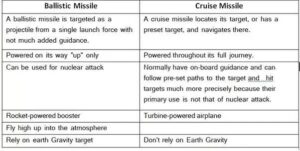In news- DRDO successfully flight tested the new generation nuclear-capable ballistic missile, Agni-P, at Integrated Test Range (ITR) in Chandipur off the coast of Odisha.
About Agni-P-
- It is the first of the new class of Agni missile to be launched by DRDO.
- It is the sixth missile in the Agni (missile) series of ballistic missiles.
- The ballistic missile weighs 50% less than Agni 3 and has new guidance and a new generation of propulsion.
- Since the missile is canisterised, it can be launched from rail and road and stored for a longer period and transported all across the country.
The missile has a range between 1000km to 2000km, and can be used to target enemy armadas in the Indo-Pacific.
About Ballistic and cruise missiles-
Ballistic Missile
- A ballistic missile follows a ballistic trajectory to deliver one or more warheads on a predetermined target.
- A ballistic trajectory is the path of an object that is launched but has no active propulsion during its actual flight (these weapons are guided only during relatively brief periods of flight).
- The trajectory is fully determined by a given initial velocity, effects of gravity, air resistance, and motion of the earth (Coriolis Force).
- Shorter range ballistic missiles stay within the Earth’s atmosphere.
- Longer-ranged intercontinental ballistic missiles (ICBMs), are launched on a sub-orbital flight trajectory and spend most of their flight out of the atmosphere.
Types of ballistic missiles based on the range are-
- Short-range (tactical) ballistic missile (SRBM): Range between 300 km and 1,000 km.
- Medium-range (theatre) ballistic missile (MRBM): 1,000 km to 3,500 km.
- Intermediate-range (Long-Range) ballistic missile (IRBM or LRBM): 3,500 km and 5,500 km.
- Intercontinental ballistic missile (ICBM): 5,500 km +
Cruise missile
- A cruise missile is a guided missile (target has to be pre-set) used against terrestrial targets.
- It remains in the atmosphere throughout its flight.
- It flies the major portion of its flight path at approximately constant speed.
- Cruise missiles are designed to deliver a large warhead over long distances with high precision.
- Modern cruise missiles are capable of travelling at supersonic or high subsonic speeds, are self-navigating, and are able to fly on a non-ballistic, extremely low-altitude trajectory.
Types of cruise missiles based on speed are-
- Hypersonic (Mach 5): these missiles would travel at least five times the speed of sound (Mach 5). E.g. BrahMos-II.
- Supersonic (Mach 2-3): these missiles travel faster than the speed of sound. E.g. BrahMos.
- Subsonic (Mach 0.8): these missiles travel slower than the speed of sound. E.g. Nirbhay.

















